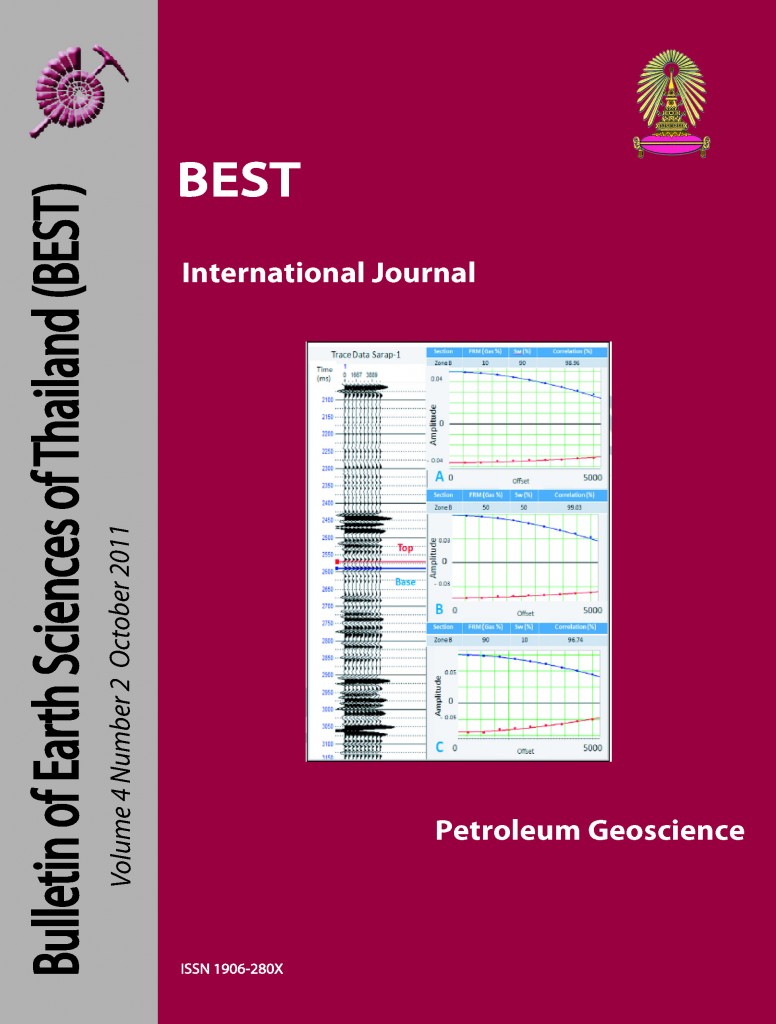Structural Style and Fracture Characteristics of Thrusted and Folded Permian Carbonates in the Siam City Cement Company Quarry, Tabkhwang, Saraburi Province, Central Thailand; Analogs for Fractured Carbonates
Main Article Content
Abstract
The Saraburi group Permian limestone is well exposed in the Siam City Cement quarry and is made up of a variety of limestone lithofacies, showing variable degrees of deformation and fracture intensity. It provides an excellent opportunity for the study of fracture character and its relation to structural style. Rock units were classified into six lithofacies, which are: thick bedded limestone, highly sheared cataclastic limestone / siliceous carbonate mudstone interbedded with shale, medium to thick bedded limestone, well-bedded limestone, shale with andesitic intrusives and dolomitic limestone. Six lithofacies were grouped and interpreted as equivalent to Phu Phe formation (Well-bedded limestone, shale with fine grained andesite), which is the oldest formation and Khao Khad formation (thick bedded limestone, siliceous carbonate shale and medium to thick bedded limestone) that is the youngest formation. The Phu Phe formation tectonically overlies the Khao Khad formation. Three thrust faults are present, trending approximately northwest-southeast with dips varying from 7o – 64o SW. Synforms and antiforms show Z asymmetrical folds, chevron folds, tight folds and similar (class 3) folds, all are present regionally and fault-propagation folds are associated with the main thrust. Three fracture sets are present, they are; longitudinal, transverse and oblique sets. The longitudinal (parallel to fold axis) set hosts the highest fracture density and is best developed in the areas close to the main fold hinges and intensity varies with distance to the fold and shows the highest density in thin-bedded limestones. Of the other two sets of fractures found in the area, the transverse set (perpendicular to fold axis) has a lesser density compared to the longitudinal set. The gamma log in all the measure limestone cores is consistently low, and the level of calcite veining (which was consistently seen to be composed of nonuraniferous vein calcite) did not sufficiently change the low background gamma signal to be visible in the log. The spectral gamma results of this study shows that a gamma log cannot be used to define zones of fracturing in a Permian carbonate host in Thailand. Stable oxygen and carbon isotope results show a consistently depleting trend that is at the higher temperature end of the marine carbonate normal burial trend. The two-plot fields (matrix and calcite veins) overlap indicates the ongoing recrystallisation of the matrix as the rocks were buried more deeply, fractured and deformed. The similarity of their plot fields also argues that most of the fluids precipitating as calcite veins were locally derived and not transported substantial distances as anomalous fault-fed fluids. The improved understanding of fracture characteristics and controls, related to the macroscopic structural geometry that comes from this work will contribute to the construction of better fracture reservoir models and their use in the optimal administration of fractured carbonate reservoirs in this region and elsewhere in SE Asia.
Article Details

This work is licensed under a Creative Commons Attribution-NonCommercial-NoDerivatives 4.0 International License.
Copyright © 2008 Department of Geology, Faculty of Science, Chulalongkorn University. Parts of an article can be photocopied or reproduced without prior written permission from the author(s), but due acknowledgments should be stated or cited accordingly.
References
Hinthong, C., Chuaviroj, S., Kaewyana, V., Srisukh, S., and Pholprasit, C., 1981, Geology and Mineral Resources of the Map Sheet Changwat Phranakhon Sri Ayutthaya (ND 47-8): Department of the Mineral Resources, Geological Survey Report no.4 (in Thai).
Nelson, C. S., and Smith, A. M., 1996, Stable oxygen and carbon isotope compositional fields for skeletal and diagenetic components in New Zealand Cenozoic nontropical carbonate sediments and limestones: a synthesis and review: New Zealand Journal of Geology and Geophysics, v. 39, p. 93107.
Pothong, P., 1985, The geological and structure of Ratburi Group in a portion of the Eastern part of Changwat Saraburi, Central Thailand, Master thesis Chulalongkorn University.
Susanto, W., 2010, Diagenetic and isotopic evolution recorded in calcite cements in a large Indosinian Fault Zone in Permian platform interior carbonates, North Central Thailand: M Sc Research Report, Chulalongkorn University, 83 p.


